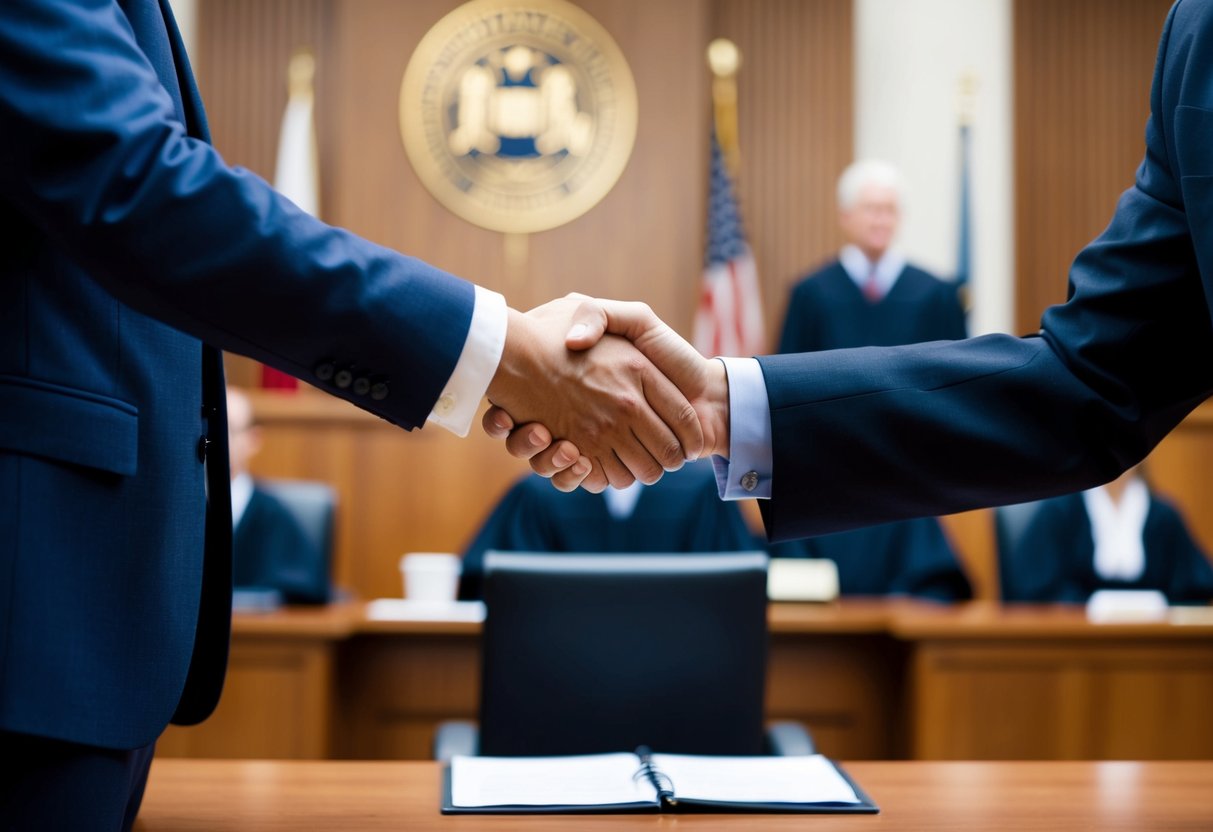Understanding Plea Bargaining

Plea bargaining plays an important role in our criminal justice system. By facilitating agreements between defendants and prosecutors, cases are often resolved more swiftly and efficiently. This process involves multiple parties and different types of agreements that can influence the outcome of a criminal case.
The Legal Framework of Plea Bargaining
Plea bargaining operates within a legal framework set by laws and court decisions. Cases like Lafler v. Cooper, Missouri v. Frye, and North Carolina v. Alford have shaped our system. These rulings address issues of effective legal counsel and the acceptability of certain plea deals.
Prosecutorial discretion allows prosecutors to offer plea deals based on the evidence and circumstances. Defendants may accept lesser charges or sentences in exchange for a guilty plea. This speeds up case processing and reduces the burden on courts.
Roles in Plea Negotiations
In plea negotiations, prosecutors and defense attorneys play key roles. Prosecutors assess the strength of their case and the evidence available. They then propose deals that might involve reduced charges or sentences. Defense attorneys evaluate these offers to see if they serve the defendant’s best interests.
Defendants ultimately decide whether to accept a plea bargain. Judges review the agreements to ensure they are fair and legal. The collaboration among these roles helps maintain balance and fairness in the criminal justice system.
Types of Plea Bargains
There are different types of plea bargains we often encounter. Charge bargaining involves reducing the severity of charges in exchange for a guilty plea. Sentence bargaining allows defendants to plead guilty for a lesser sentence.
Fact bargaining is less common, where both parties agree on which facts will be introduced to reduce charges. Each type offers its own benefits and risks. An understanding of these can shape the strategy in a criminal case, guiding defendants through difficult decisions.
Evaluating Outcomes and Fairness

In plea bargaining, we focus on sentencing outcomes and how they impact fairness for all parties involved. We also consider how these outcomes may influence recidivism rates and the transparency of the process.
Assessing Sentencing Outcomes
When evaluating sentencing outcomes, we look at how plea bargains lead to reduced charges and lighter sentences. These outcomes often benefit defendants by limiting collateral consequences.
We also assess if effective assistance of counsel was provided to ensure fairness. On the other hand, ineffective assistance of counsel can result in unfair agreements. Sentencing outcomes should reflect just practices and align with community standards, often referred to as going rates.
Effect on Recidivism
Plea bargains can influence recidivism rates by providing defendants with opportunities for rehabilitation. These deals often come with plea discounts, encouraging defendants to accept programs that may reduce repeat offenses.
While some argue that shorter sentences may lead to higher recidivism, others believe that rehabilitative measures offered in place of longer sentences can be beneficial. Our goal is to analyze if these bargains effectively lower recidivism.
Fairness and Transparency in Plea Deals
The fairness of plea deals depends largely on transparency. We examine whether defendants fully understand the consequences, including both direct sentencing and potential collateral effects.
Transparency ensures everyone involved comprehends the terms and the implications. It’s vital that defendants are informed of their rights and the potential outcomes. There is a need for reforms to increase transparency and guarantee fairness, which can also build trust in the justice system.
High-Profile Case Studies
Plea bargains can shape legal outcomes in the United States. Studying high-profile cases, we learn about their consequences and how they influence the training of future legal professionals.
Impact of Prominent Plea Bargains
We examine several well-known cases that have left a lasting impact. Lafler v. Cooper and Missouri v. Frye highlight the importance of competent legal advice during plea negotiations. These cases emphasize how incorrect advice can affect a fair trial outcome.
The North Carolina v. Alford decision allowed defendants to plead guilty without admitting guilt. This raised questions about defendant rights and judicial efficiency.
In Padilla v. Kentucky, the focus was on how attorneys must inform clients of deportation risks stemming from guilty pleas.
These cases have profoundly influenced the legal landscape for defendants nationwide.
Case Study Analysis for Law Students
These high-profile cases serve as learning tools for law students. By analyzing these situations, students better understand how plea bargaining works and its effects on both the criminal justice system and defendants.
Lafler v. Cooper and Missouri v. Frye teach the significance of legal advice in plea deals. Students learn how inadequate counsel can result in appeals and retrials.
The case of Padilla v. Kentucky educates students on the need for attorneys to consider not only courtroom outcomes but also life-altering consequences like deportation.
Reviewing these cases helps future attorneys grasp essential principles and prepare for real-world challenges.
Impact on Legal Professionals and Defendants
Plea bargaining plays a crucial role in how legal professionals and defendants navigate the justice system. Our focus will be on how defense attorneys make decisions and what plea deals mean for defendants’ futures.
Decision-Making for Defense Attorneys
When preparing to negotiate a plea deal, we as defense attorneys assess the strength of evidence, the chances of winning in court, and potential sentences. A key factor is understanding the likelihood of a guilty plea leading to a reduced sentence or avoiding incarceration. This requires insights into both the prosecution’s stance and the tendencies of local criminal courts.
Cases involving potential wrongful convictions necessitate an even more careful analysis. Our goal is to ensure that innocent defendants are not pressured into accepting unfair agreements. Factors such as defendant race can unfortunately influence legal proceedings, highlighting a need for vigilance.
Plea bargains can also streamline legal proceedings significantly. With fewer cases going to trial, the workload for us as legal professionals can become more manageable. This efficiency allows for dedicated attention to more complex trials.
Effects on Defendants and Employment Opportunities
A negotiated agreement through a plea bargain can impact a defendant’s future employment opportunities. Pleading guilty may reduce immediate penalties but could result in a criminal record affecting job prospects.
We see that access to justice often varies depending on factors like the availability of qualified criminal defense attorneys. For some defendants, accepting a plea bargain may seem like the most viable option, even if they believe in their innocence.
Significant disparities exist within the system. Studies indicate that the race of the defendant might affect outcomes. We must remain aware of these disparities to advocate for fair treatment. Recognizing these challenges helps us better support defendants in navigating their legal and professional futures.
Future Directions in Plea Bargaining
As we look towards the future of plea bargaining, it’s important to focus on potential reforms and innovations. We will explore changes in sentencing and charge bargaining, new approaches in fact bargaining, and how increased transparency can enhance access to justice.
Reforms in Sentencing and Charge Bargaining
Reforms in sentencing and charge bargaining may impact how plea deals are structured. We might see more consistent sentencing rules to reduce disparities. Clear guidelines could ensure more fairness for defendants facing similar charges. Sentencing reform aims to limit the influence of collateral consequences on defendants’ lives.
Improving charge bargaining could involve setting limits on charges that can be included in a plea deal. These changes can make the process fairer for all involved and help restore trust in our legal system.
Innovations in Fact Bargaining Practices
Innovations in fact bargaining could change how facts are negotiated in plea deals. Fact bargaining often involves agreeing on which facts are presented in court to support a guilty plea.
We could find new approaches for ensuring these facts are accurate and fair. Our focus may include using technology to document negotiations more clearly. This would help protect defendants’ right to trial by ensuring they are not unfairly persuaded into agreements.
Enhancing Access to Justice Through Transparency
Transparency in plea bargaining provides defendants greater access to justice. We aim for procedures that allow defendants to fully understand their rights and options. Public oversight and documentation can reduce secrecy, making the process more equitable.
Increased transparency might include keeping records of negotiations. Such measures would allow for monitoring and evaluation of the plea bargaining process. By shining a light on these proceedings, we can ensure fairness and accountability.




